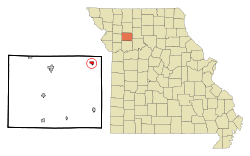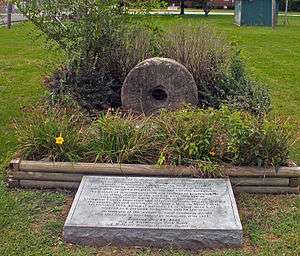Breckenridge, Missouri
Breckenridge is a city in Caldwell County, Missouri, and is part of the Kansas City metropolitan area with the United States. The population was 383 at the 2010 census.
Breckenridge, Missouri | |
|---|---|
 Location of Breckenridge, Missouri | |
| Coordinates: 39°45′41″N 93°48′15″W | |
| Country | United States |
| State | Missouri |
| County | Caldwell |
| Area | |
| • Total | 0.55 sq mi (1.43 km2) |
| • Land | 0.55 sq mi (1.42 km2) |
| • Water | 0.00 sq mi (0.00 km2) |
| Elevation | 922 ft (281 m) |
| Population | |
| • Total | 383 |
| • Estimate (2018)[3] | 358 |
| • Density | 653.92/sq mi (252.26/km2) |
| Time zone | UTC-6 (Central (CST)) |
| • Summer (DST) | UTC-5 (CDT) |
| ZIP code | 64625 |
| Area code(s) | 660 |
| FIPS code | 29-08128[4] |
| GNIS feature ID | 0714664[5] |

History
Breckenridge was laid out in 1856, and named for Vice President John C. Breckinridge.[6] A post office called Breckenridge has been in operation since 1860.[7]
Geography
Breckenridge is located at an altitude of 927 feet (283 m).
According to the United States Census Bureau, the city has a total area of 0.55 square miles (1.42 km2), all land.[8]
Demographics
| Historical population | |||
|---|---|---|---|
| Census | Pop. | %± | |
| 1870 | 515 | — | |
| 1880 | 777 | 50.9% | |
| 1890 | 768 | −1.2% | |
| 1900 | 1,012 | 31.8% | |
| 1910 | 1,025 | 1.3% | |
| 1920 | 860 | −16.1% | |
| 1930 | 828 | −3.7% | |
| 1940 | 728 | −12.1% | |
| 1950 | 617 | −15.2% | |
| 1960 | 605 | −1.9% | |
| 1970 | 598 | −1.2% | |
| 1980 | 523 | −12.5% | |
| 1990 | 418 | −20.1% | |
| 2000 | 454 | 8.6% | |
| 2010 | 383 | −15.6% | |
| Est. 2018 | 358 | [3] | −6.5% |
| U.S. Decennial Census[9] | |||
2010 census
As of the census[2] of 2010, there were 383 people, 160 households, and 97 families residing in the city. The population density was 696.4 inhabitants per square mile (268.9/km2). There were 205 housing units at an average density of 372.7 per square mile (143.9/km2). The racial makeup of the city was 92.4% White, 0.5% African American, 1.8% Native American, 0.5% from other races, and 4.7% from two or more races. Hispanic or Latino of any race were 0.8% of the population.
There were 160 households, of which 32.5% had children under the age of 18 living with them, 37.5% were married couples living together, 16.3% had a female householder with no husband present, 6.9% had a male householder with no wife present, and 39.4% were non-families. 33.8% of all households were made up of individuals, and 11.2% had someone living alone who was 65 years of age or older. The average household size was 2.39 and the average family size was 3.04.
The median age in the city was 38.4 years. 27.7% of residents were under the age of 18; 8.5% were between the ages of 18 and 24; 22.1% were from 25 to 44; 28.5% were from 45 to 64; and 13.1% were 65 years of age or older. The gender makeup of the city was 52.2% male and 47.8% female.
2000 census
As of the census[4] of 2000, there were 454 people, 191 households, and 123 families residing in the city. The population density was 822.1 people per square mile (318.7/km2). There were 230 housing units at an average density of 416.5 per square mile (161.5/km2). The racial makeup of the city was 96.48% White, 1.76% Native American, 0.22% Asian, 0.44% from other races, and 1.10% from two or more races. Hispanic or Latino of any race were 0.44% of the population.
There were 191 households, out of which 30.9% had children under the age of 18 living with them, 45.5% were married couples living together, 13.1% had a female householder with no husband present, and 35.6% were non-families. 31.4% of all households were made up of individuals, and 12.0% had someone living alone who was 65 years of age or older. The average household size was 2.38 and the average family size was 3.02.
In the city the population was spread out, with 28.6% under the age of 18, 8.1% from 18 to 24, 27.8% from 25 to 44, 22.0% from 45 to 64, and 13.4% who were 65 years of age or older. The median age was 34 years. For every 100 females, there were 107.3 males. For every 100 females age 18 and over, there were 102.5 males.
The median income for a household in the city was $23,625, and the median income for a family was $28,750. Males had a median income of $24,712 versus $14,464 for females. The per capita income for the city was $12,468. About 13.7% of families and 23.2% of the population were below the poverty line, including 34.8% of those under age 18 and 9.0% of those age 65 or over.
Education
Breckenridge R-I School District operates one elementary school and Breckenridge High School.[10]
References
- "2017 U.S. Gazetteer Files". United States Census Bureau. Retrieved Jan 10, 2019.
- "U.S. Census website". United States Census Bureau. Retrieved 2012-07-08.
- "Population and Housing Unit Estimates". Retrieved March 28, 2020.
- "U.S. Census website". United States Census Bureau. Retrieved 2008-01-31.
- "US Board on Geographic Names". United States Geological Survey. 2007-10-25. Retrieved 2008-01-31.
- Eaton, David Wolfe (1916). How Missouri Counties, Towns and Streams Were Named. The State Historical Society of Missouri. pp. 266.
- "Post Offices". Jim Forte Postal History. Archived from the original on 6 March 2016. Retrieved 7 September 2016.
- "US Gazetteer files 2010". United States Census Bureau. Archived from the original on 2012-01-25. Retrieved 2012-07-08.
- "Census of Population and Housing". Census.gov. Retrieved June 4, 2015.
- "Breckenridge R-I School District". Greatschools. Retrieved 18 March 2018.
External links
- Historic maps of Breckenridge in the Sanborn Maps of Missouri Collection at the University of Missouri
